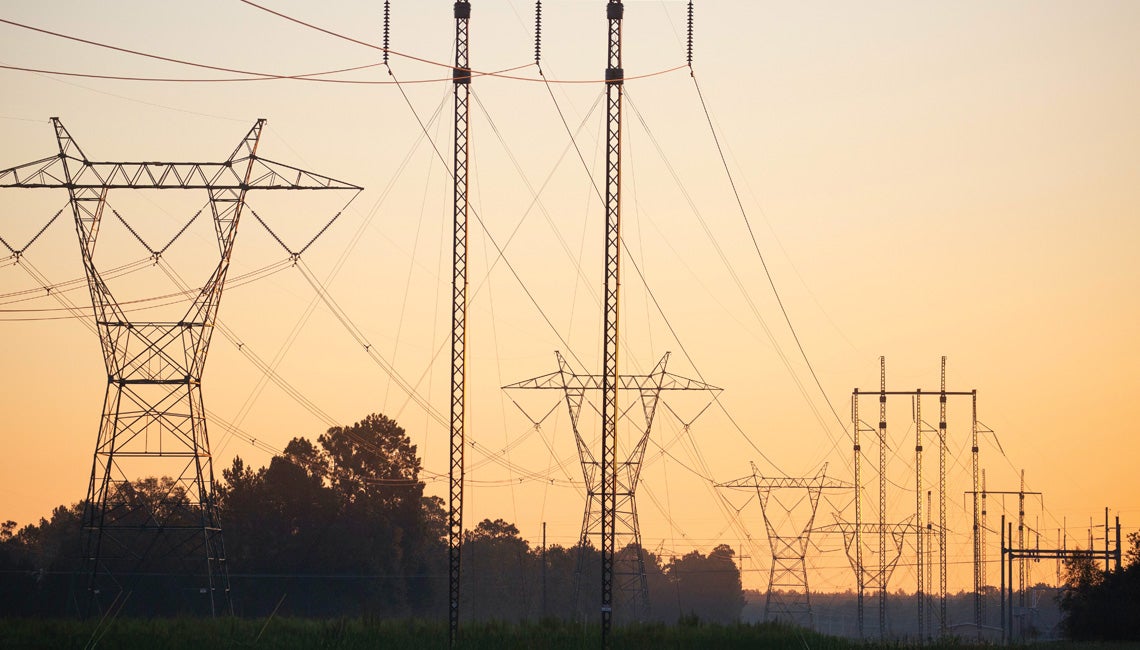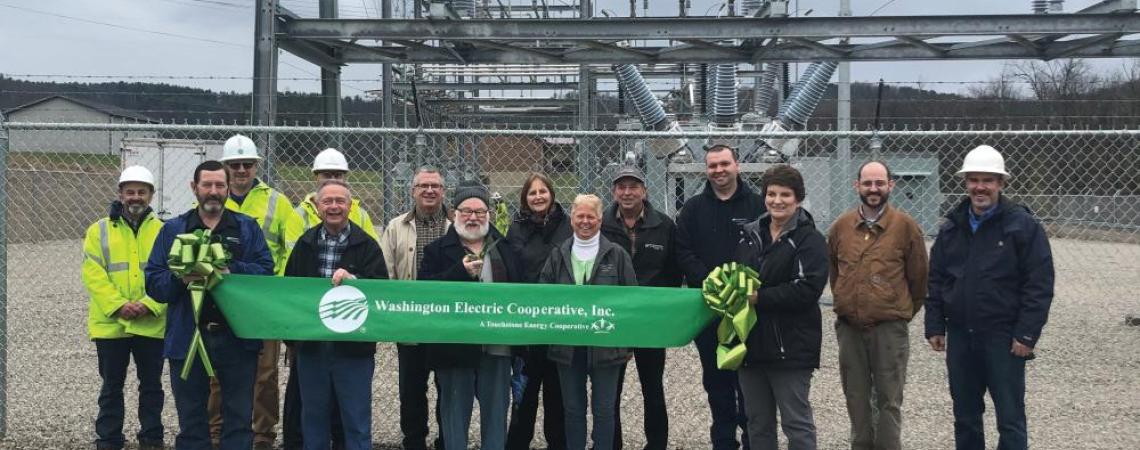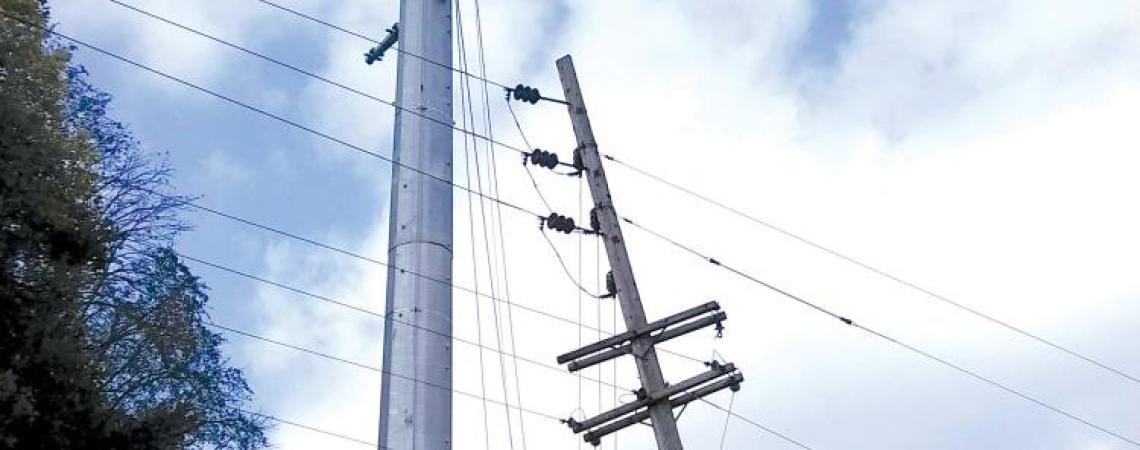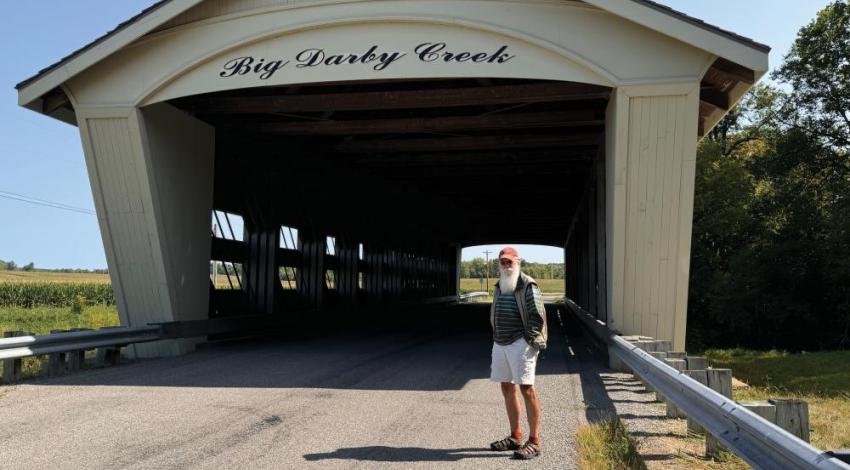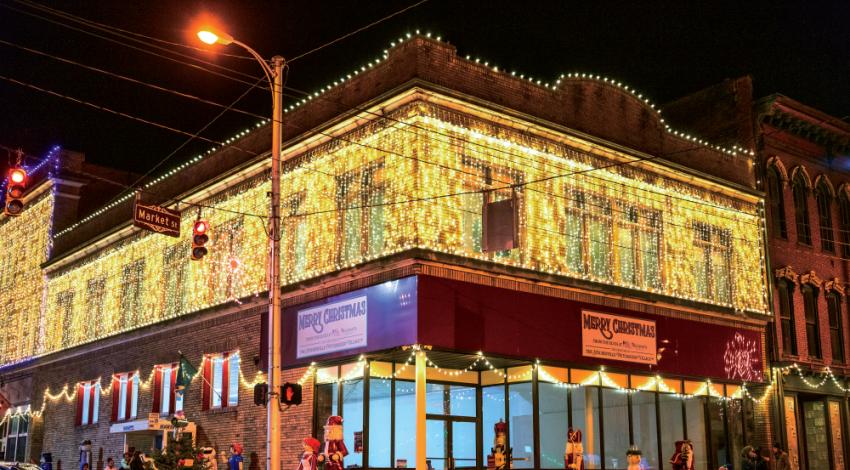Larry Kelly remembers a time, from the late 1990s into the mid-2010s, when any strong wind could cause him to lose power at his home near Graysville for a couple of hours — or longer.
“When there was a more serious storm, outages of eight hours were typical, and that could happen once a month or more,” Kelly says. “I went out of town for a week one summer and there was a long outage. When I came home, my refrigerator was like a biosphere. I tried everything — including skunk spray — to get rid of the smell. It took a box of activated charcoal with a fan for a week to save my refrigerator.”
Washington Electric member Larry Kelly, at center with scissors, participated in the ribbon-cutting for the co-op’s new Rouse substation in January 2020.
Kelly knew that personnel from his co-op, Marietta-based Washington Electric Cooperative, were doing everything they could to provide reliable power for him and all of his neighbors in that area of Monroe County. The problem was that many of the outages were occurring before electricity even reached the co-op’s substations.
Lost in transmission
The problem wasn’t a lack of power generation — the Cardinal Power Plant and other assets of Buckeye Power, the co-op-owned generating company that serves Ohio’s cooperatives, were producing plenty of electricity. And the problem usually wasn’t in the nearly 1,800 miles of Washington Electric’s lines that run from substations to members’ individual homes and businesses.
The problem lay in transmission, the movement of electricity between the power plant and the co-op along high-voltage lines that, for the most part in Ohio, are owned and maintained by investor-owned utility companies.
“Our local co-ops do their best to maintain their lines, but there are things that are beyond their control,” says Tom Schmidt, principal planning engineer for Ohio’s Electric Cooperatives, the statewide trade and service organization that includes Buckeye Power. “Unfortunately, when transmission goes out, you’re talking about a whole substation, so it’s hundreds and hundreds of co-op members affected. These outages often occur during snowstorms or ice storms — the worst possible times — and all the co-op can do is wait for transmission to come back.”
In Kelly’s case, Washington Electric was reliant at the time on West Virginia-based Monongahela Power, which showed little interest in maintaining or upgrading the transmission infrastructure in the corner of Ohio it served. When American Electric Power purchased Monongahela’s assets in 2005, it faced a daunting task.
“The transmission system was low-voltage and had become antiquated,” says Jeff Triplett, Washington Electric’s general manager. “It was very unreliable. Our substations were among the worst delivery points in the state, in terms of number and duration of outages. They affected 500 or 800 people at a time, and this went on for many years. It was very frustrating for our members.”
To complicate matters, that area of southeastern Ohio, including large chunks of the Wayne National Forest, is hilly, densely wooded, sparsely populated, and generally a difficult and expensive place to build transmission infrastructure. (Monroe County has been called “The Switzerland of Ohio” because of its rugged terrain, which may have attracted its early Swiss settlers.)
Reliability improves, at a cost
Washington Electric and Ohio’s Electric Cooperatives worked with AEP on an extensive plan to improve reliability. AEP would replace old 23-kilovolt transmission lines with new 138-kV lines, and they would be networked — providing the ability to backfeed electricity from another direction if one transmission line went out. Washington Electric would build new 138-kV substations to transfer power into its local distribution system.
This comprehensive rebuild required substantial investments — in time, effort, and money. AEP spent some $250 million on new transmission lines, replacing dilapidated wooden poles with durable steel structures. The costs for such upgrades are recouped through higher rates charged to consumers, Schmidt says. Those rates are federally regulated, and for the past 10 to 15 years, regulators have been granting rate increases that have made it feasible and even appealing for the investor-owned utilities to make such improvements.
Co-ops pass transmission charges through to members at cost, usually noted on electric bills within a generation and transmission, or G&T, line item. (The “G” portion goes to the electric producer — Buckeye Power for Ohio co-ops — and those rates have stayed relatively stable, Schmidt says.)
“Transmission cost is a real concern,” Triplett says. “It’s gone up astronomically, and members notice it on their bills. We’ve been lucky that we can say although those costs are going up, at least our members are seeing results. They notice the difference in improved reliability.”
Looking forward
The need for transmission infrastructure continues to grow, Schmidt says, driven by ever-increasing demand for electricity. That means transmission costs will keep growing as well.
Ohio’s electric cooperatives, both locally and through the statewide group, will continue to advocate for investments that help co-op members and rural areas — not just those that feed more data centers in central Ohio.
“We have several active projects in development,” Schmidt says. “A lot of times, we recognize costs are going up, but we know we stand to benefit greatly from those investments. We’re looking for the same success we had with Washington Electric, and applying it elsewhere.”
Larry Kelly, for one, appreciates the improved reliability to the remote area he calls home.
“Today, outages are so doggone rare,” he says. “I’m very appreciative of how far they’ve come and how good the service is today.”
Transmission in transition
Although the topography around Firelands Electric Cooperative in New London — plains that are friendly to corn and soybean fields — may not be as rugged as the forested hills around Washington Electric, Firelands has also experienced transmission troubles.
“For about 50 years, we had about half of our substations, serving 60% of our members, on transmission lines that dead-ended at one of our substations,” says Don Englet, Firelands’ general manager. Such “radial feeds” lack a loop connecting to an alternate transmission source, so if the incoming line goes down, everyone on the substation loses power.
Ohio’s Electric Cooperatives’ power transmission group negotiated with transmission provider First Energy to loop one substation to another in 2019, providing a two-way feed to about 40% of members. But the co-op’s largest substation, in New London, was still on a radial feed with no backfeeding option. “If we lost that transmission feed, 1,800 members were left in the dark,” Englet says.
In June of 2023, that feed was off for nearly 47 hours. “We communicate with members that although we own the generation of electricity (through Buckeye Power), we don’t own the transmission,” Englet says. “But that doesn’t make it any less frustrating for them when the power is out.”
So Firelands and OEC negotiated with First Energy and AEP, which were working to interconnect their transmission systems, to place the tie point at the co-op’s New London substation. Once the project is complete, the station will have transmission feeds from both companies, so if one goes out, the other can still provide service.
“This will benefit us tremendously,” Englet says. “We’ve seen improvements on our northern substations since 2019, and this will be another huge boost for reliability.”
What is a G&T?
When most co-op members in Ohio look at their electric bills, they may note a charge for generation and transmission — separate from what they pay the co-op to build, maintain, and manage local distribution of electricity. It’s usually a significant portion of the bill.
But where does it come from?
Electric cooperatives in Ohio collectively own and are members of Buckeye Power, a generation and transmission cooperative, or G&T, they formed in 1959 to get them the power that keeps their members’ lights on.
While some of the country’s 64 G&Ts both generate and transmit the power they deliver to their member co-ops, others may simply purchase wholesale power on the open market and/or pay to use high-voltage transmission systems owned by others to deliver it.
Buckeye Power owns ample generation resources — the coal-fired Cardinal Power Plant, two natural gas peaking plants, and a variety of renewable sources — to produce plenty of reliable power and at the same time keep it as affordable as possible.
“We have sufficient generation to meet members’ needs now and in the foreseeable future, even with the significant load growth we’re expecting,” says Craig Grooms, president and CEO of Ohio’s Electric Cooperatives (the statewide organization that includes Buckeye Power). “Owning and operating our own generation, depending on ourselves rather than external suppliers, allows us to control that part of our costs, for the most part, and insulates us from a lot of price volatility.”
The G&T’s power delivery group then works with companies that own the high-voltage lines in the state to coordinate transmission of that power to the local distribution co-ops.
That’s where co-op members have seen the most significant increases in their bills lately.
Ohio’s transmission infrastructure is mostly owned by investor-owned utilities like AEP, First Energy, AES, and Duke Energy, which charge transmission fees. (A few local co-ops in the state own some transmission lines as well.)
“We arrange for transmission service, buying capacity on the transmission grid,” Grooms says. “In return, we expect good operations, good service, and good reliability, and we make sure those partners are fulfilling their obligations.”
At the same time, Grooms says, co-ops advocate for transmission improvements when they’re needed. “Obviously, those upgrades cost money,” he says. “We recognize that some of the investments that benefit co-op members most will result in higher transmission costs.”
It’s important to note that, just like each of Ohio’s 24 local distribution co-ops, Buckeye Power is a not-for-profit entity.
“The ‘G’ and the ‘T’ are provided at cost,” Grooms says. “When that shows up on members’ bills, it’s a straight pass-through. There’s no mark-up and no profit for the co-op.”
